How to Hand Train a Bird
You may not be able to get your parakeet to balance a ball on his beak, but every hook-billed species -- from parakeets to cockatoos -- can be trained to step onto your finger when you tell him to.
Step 1: Train only wing-clipped birds
Don’t try to take your bird out of his cage unless his wings have been clipped.
Step 2: Desensitize bird
To get your bird not to flip out when you put your hand into his cage, several times a day insert your hand into the cage and wave it slowly in the bird’s direction. Repeat this daily until the bird gets used to it.
Tip
Try holding a bird treat when you put your hand into the cage. Once you can get your bird to eat from your hand, you’re well on the way toward establishing 'hand trust.'
Step 3: Hold perch or stick
For the next two weeks, insert your hand into the cage several times a day--but this time, hold a perch or stick in your hand. Your goal: getting the bird to step onto the perch.
Step 4: Trigger “step up” reflex with perch
When the bird gets used to the perch in your hand, start getting him to step onto it. Hold it at a right angle to the bird’s body and gently nudge him in the chest. This will trigger his 'step up' reflex.
Tip
Always say 'Up, up' or 'Step up' when you nudge the bird with the perch. Give him lots of praise when he steps onto it. He’s making progress!
Step 5: Replace perch with hand
When the bird is comfortable standing on a hand-held perch, you can start training him to stand on your hand alone. During each training session, move your hand farther down the perch -- and closer to the bird.
Step 6: Discard perch
After a few days, your bird should assume that a perch comes with a hand attached--so now it’s time to up the ante once again. What’s next? That’s right: your hand without the perch.
Step 7: Trigger “step up” reflex with hand
Moving slowly and smoothly and repeating the 'Up, up' command, nudge the bird in the chest until he has no choice but to step onto your pointer finger to steady himself.
Step 8: Repeat
Repeat this procedure until the bird has no problem stepping onto your finger and perching there.
Step 9: Practice outside of cage
Now you and your feathered friend can begin working outside the cage. With the bird perched on your finger, slowly and smoothly bring him out through the cage door.
Tip
If you have a large bird, a T-stand will be a helpful training tool when working outside the cage. Practice putting the bird onto the T-stand and taking him off again.
Step 10: Practice verbal command
Practice the 'Up, up' command diligently until the bird knows that he should always step onto your 'finger perch' when you say so.
Tip
If the bird gets startled and flutters off your hand, calmly follow him to where he lands and nudge him, saying 'Up, up.' Usually, he’ll step right back onto your finger.
Step 11: Enlist friends and relatives
Encourage your friends and relatives to work with your bird as much as possible. The tamer a bird becomes, the happier his relationship with his human flock will be.
Did You Know?
Birds in the parrot family have two toes facing forward and two facing backward, to help them hold onto things while they’re climbing.
-
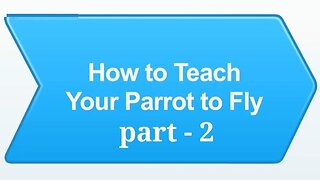 2:08
2:08
Kanhaiyakamat
1 year agoHow to teach your parrot to Fly | parrot training part - 2 Easy steps...
112 -
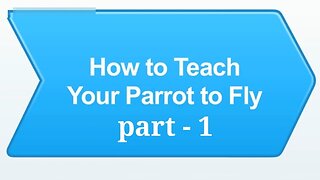 1:14
1:14
Kanhaiyakamat
1 year agoHow to teach your parrot to Fly | parrot training part - 1 Easy steps...
54 -
 1:45
1:45
Our Off Grid Life - Why not now?
1 year agoA Bird In Hand
8 -
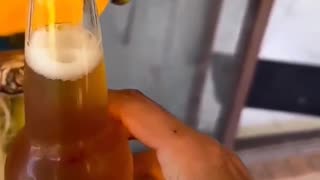 0:13
0:13
China's People
7 months ago#Bird-in-the-hand
1 -
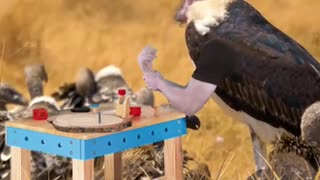 0:47
0:47
Funny Animal's
2 years ago $0.01 earnedIf birds had arms
1491 -
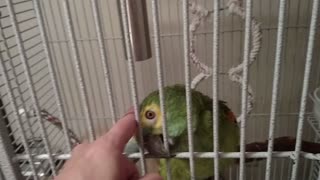 1:23
1:23
AFV
6 years agoTalking Bird Loves Being Petted On The Head, Crying Words Of Satisfaction
19.5K -
 0:38
0:38
Yaminnp
1 year agoTalking bird sit my hand
9 -
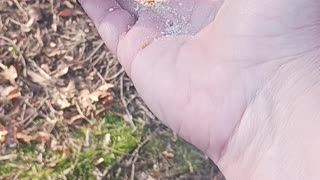 0:14
0:14
Islanders13
1 year agoBirds in my hand
73 -
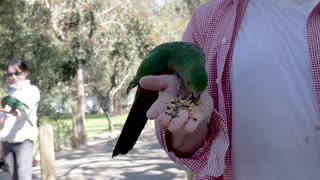 0:08
0:08
PapaPiolo
2 years agoBird feeding in my hand
23